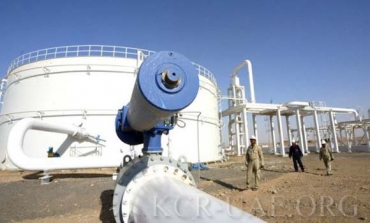Oil price falls more than $1 amid investor fears

Central banks in China, the euro zone and Britain on Thursday eased policy in the space of less than one hour, underscoring growing worries about the global economy that have muddied the demand outlook for commodities.
Brent slipped $1.24 to $99.46 per barrel by 8.44am UAE time, trading at the session low, while US crude shed $1.09 to trade at $86.11 a barrel, although both were on track for a second straight weekly gain.
"The focus continues to be on the global economy and oil demand," said Victor Shum, a senior partner at oil consultancy Purvin & Gertz.
"China's rate cut was a surprise and although it was meant to stimulate, it was interpreted as a sign of more trouble in the economy and it didn't really inspire.
"Brent is supported by the escalation of the labour dispute in Norway, but the focus remains on demand."
Investors are now focusing on the all-important US jobs data due later on Friday, which is expected to provide clues on the state of the world's biggest economy.
Norway's oil unions moved to lock out all offshore workers on the Norwegian continental shelf on Thursday, to put an end to a near two-week strike that has hit crude exports and helped push up prices.
While a lockout would mean a complete shutdown of oil and gas production in the world's eight-biggest exporter, analysts expect it to force the government to intervene and end the strike to prevent a full closure.
The strike, which began June 24, has already slowed crude exports and cut Norway's oil production by around 13 percent and its gas output by around 4 percent.
Worries about supply from Norway drove Brent to a one-month top above $102 per barrel on Thursday, but prices gave up some of their gains as the euro slid against the dollar after the European Central Bank cut rates.
Also supporting prices, US crude oil inventories fell 4.27 million barrels last week, according to the weekly report from the US Energy Information Administration. A Reuters poll had forecast a 1.9 million-barrel decline.
Monetary easing on Thursday by three major central banks - the European Central Bank, the Bank of England and the People's Bank of China - added to investor unease about the global slowdown.
Next in line is the non-farm payrolls data from the US due later on Friday. Employers are expected to have added 90,000 new workers to their payrolls, according to a Reuters survey. That would be tepid but still better than the 69,000 jobs created in May, which was the fewest in a year.
In line with weakening expectations, Barclays Capital on Thursday lowered its 2012 Brent crude oil price forecast by $7 to an average $113 per barrel while maintaining its forecast for 2013 at $125 per barrel.
While investors were monitoring the dispute between Iran and the west over Tehran's nuclear programme, after US and European Union's sanctions took effect in recent weeks, overall global worries continued to take precedence.
"The fact is that if there was ever a good time to have barrels off the market because of an embargo, this is the right time. We are seeing a lot of weak economies right now and because of that demand is suffering," said Carl Larry, president of Oil Outlooks in New York.
Source: Reuters












